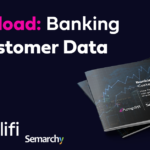Why every bank needs a 360-view of every customer in today’s challenging financial landscape
Does customer loyalty really exist in the banking sector? Maybe once it did – back in the days when people had a local branch and a personal relationship with their bank manager. Or maybe that’s really a myth we’ve all bought into by watching It’s a Wonderful Life too many times.
Either way, the idea of ‘customer loyalty’ to a particular financial brand has dated. Today, loyalty is hard won, and easily bought (however temporarily) by a better offer, or a new service. While digital has increased agility for banks, it’s also increased flexibility for customers. It’s never been easier or faster to switch a current account to a new provider or open a new savings account elsewhere. Even online-only mortgages can be approved in principle in a matter of minutes.
Simply being an established, trusted financial institution with a good reputation and a strong brand isn’t enough to maintain customers anymore. In a difficult financial market, and an increasingly digitally-led society, customers are searching for the best value, and the best experience – and they aren’t content to choose one over the other.
The challenge for mid-tier banks
 What does this mean for mid-tier banks? The strength of their offering has traditionally rested on their personal service – a bespoke approach that rivals the size and brand-visibility of the major banking institutions. The loyalty of their customers has been one of their biggest assets: with personalization being one of their biggest selling points and retention factors.
What does this mean for mid-tier banks? The strength of their offering has traditionally rested on their personal service – a bespoke approach that rivals the size and brand-visibility of the major banking institutions. The loyalty of their customers has been one of their biggest assets: with personalization being one of their biggest selling points and retention factors.
Yet in a digital world, ‘personalization’ has taken on a slightly different meaning. It’s based on data, not face-to-face relationships. Customer loyalty isn’t driven by a friendly face in a local branch: it’s won with fully customizable mobile and online services. It’s fuelled by data-driven decisions on accounts, instant communications, and full-service offerings on the go via mobile app. It’s maintained with speed, agility, and convenience.
If mid-tier banks want to keep their customers engaged and loyal, they need to have a full, 360-degree view of each and every one of them – and be ready to act on the knowledge they glean from that fully-rounded profile.
Data is, of course, the answer – but what do mid-tier banks need to do to ensure they have this complete view of every customer, and can act reliably on that data? The first step is building a strong data foundation, with one method being Governed Data Integration.
A 360-degree view from multiple data sources
Governed Data Integration brings together three processes:
- Discovering data across the enterprise
- Integrating data for analytics or operations
- Governing data through MDM and cataloging
One of the biggest challenges for banks is multiple data sources, with valuable customer data siloed across the business in various departmental repositories. One customer may have accounts in home insurance, current accounts, and customer loans with one bank, yet due to data siloes – often built up over years of creating new products and implementing new departmental data systems – that one customer has three different profiles. It’s not impossible to see that customer as a single person, but it’s difficult and takes manual effort to pull reports and analytics.

This time-consuming process just isn’t practical when a customer wants a fast response to a query, or marketing is trying to send a quick, reactive promotion. The result is twofold: data-driven processes are slowed down, or critical data is missed. For instance, a customer with a brand-new home insurance policy gets a marketing promotion, as a current account holder, for a much better rate – which it is too late for them to take up. It alienates and irritates the customer instead of fostering a sense of trust and support from their bank.
By discovering all of these data repositories, integrating them from their disparate formats – legacy databases, SaaS applications, IT system log files, etc – ready for analytics, and governing that data to fix errors and catalog metadata, Governed Data Integration enables financial services companies to get a full, accurate 360-degree view of their data. Without having to introduce one, central data repository at the start.
Can banks really consolidate all of their data?
Honestly? It’s unlikely, at least not in the near future. Financial organizations’ data landscape is always changing, always evolving, and so are customers’ data profiles. Yet by bringing together data from multiple sources using Governed Data Integration, financial services firms can start to get clarity over their customer data, creating an architecture and environment where data quality and unity are prioritized, and making it easier to recognize new data sources to bring them into the fold. It helps to create a more nuanced, complete view of customers that can be used to speed up service and personalize communications. Will this ultimately help mid-tier banks to win and retain customer loyalty in a crowded digital market? Maybe – if they can use this knowledge to offer customers what they want: the best experience, for the best possible value.
 If you’re looking to get a better view of your customer data to boost loyalty and thrive in today’s challenging financial market, we can help. Download our guide to Customer MDM in the financial sector to find out more.
If you’re looking to get a better view of your customer data to boost loyalty and thrive in today’s challenging financial market, we can help. Download our guide to Customer MDM in the financial sector to find out more.


